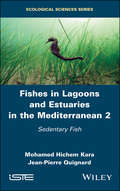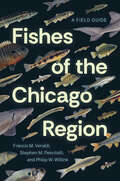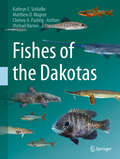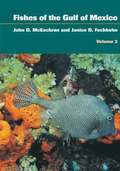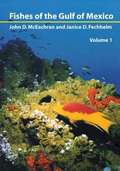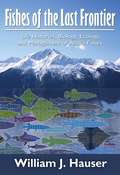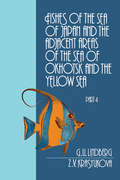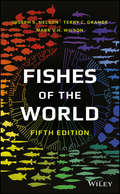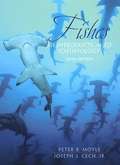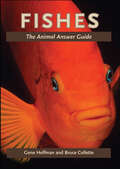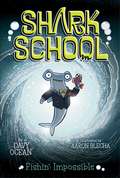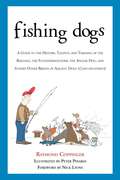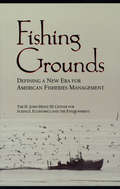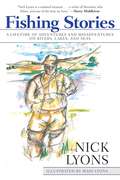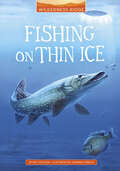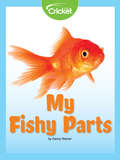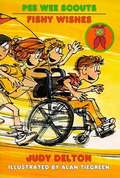- Table View
- List View
Fishes in Lagoons and Estuaries in the Mediterranean: Diversity, Bioecology and Exploitation
by Mohamed Hichem Kara Jean-Pierre QuignardLagoons and estuaries are transition spaces between earth and sea. Beyond their expanse, geographic repartition, geomorphological, hydroclimatic and ecobiological diversity and biodiversity, they play an important role in regional economies and are some of the ecosystems most vulnerable to global change. Reinforced by numerous references, this book studies Mediterranean lagoonal and estuarine fishes whose diversity largely depends on the composition of neighboring marine and continental ichtyofauna. The authors describe their morphological, biological, ecological and behavioral characteristics by evoking their distinctive features and differences with their marine or freshwater homologues. Their adaptation strategies, elucidated thanks to recent advances in morphology, genetics and molecular biology, are recognized as a major advantage in the context of climate change. This book is for natural environment managers, engineers, teachers, students and researchers.
Fishes in Lagoons and Estuaries in the Mediterranean: Sedentary Fish
by Mohamed Hichem Kara Jean-Pierre QuignardFishes in Lagoons and Estuaries in the Mediterranean 2 extensively covers the systematic, biological, ecological, behavioral and genetic aspects of the sedentary fishes that spend their entire lifecycle in the coastal fringes, sometimes referred to as “extreme environments”. This second volume of a set of books on Mediterranean ichthyofauna presents in-depth scientific, historical and current knowledge at the family, genus and species levels. Designed to give rapid and comprehensive access to the body of knowledge on Mediterranean lagoonal and estuarine sedentary fishes (over 1200 scientific works are referenced), this volume is for anyone involved in the use, management or protection of natural environments and their populations, including ecobiologists, geographers, engineers, teachers, students and researchers.
Fishes of the Chicago Region: A Field Guide
by Francis M. Veraldi Stephen M. Pescitelli Philip W. Willink“A treasure of hardcore fish intelligence and delightful tidbits of fish history.”—Dale Bowman, Chicago Sun-Times Fish don’t heed state boundaries, and neither does this comprehensive, photo-filled guide to the diverse species of Chicago and beyond. Encompassing southern Lake Michigan, northeastern Illinois, and adjacent areas of Indiana, Michigan, and Wisconsin, the Chicago Region is home to rare habitats supporting diverse fish populations. From small creeks to large rivers and from small ponds to one of the world’s largest freshwater ecosystems, Lake Michigan, these systems are home to some 164 fish species representing 31 families. In this essential field guide, the most complete and up-to-date reference for fishes in the Chicago Region, we meet them all—lampreys, sturgeon, paddlefish, gars, drum, darters, perches, sticklebacks, sculpins, and more. Written by leading local ecologists and featuring a pictorial family key, color photographs, detailed species distribution maps, and natural history observations unique to the region, this go-to guide belongs on the shelf—and in the boat—of every angler, naturalist, fisheries manager, and biologist.
Fishes of the Dakotas
by Kathryn E. Schlafke Matthew D. Wagner Chelsey A. PasbrigThis book describes all of the fishes found in North and South Dakota, USA. It contains a description of the waters and geology of the two states, information on the major rivers and water basins, detailed distribution tables, and a dichotomous key (already tested and in university use). A brief description of each fish family is included, and for each individual fish species found in North and South Dakota, high resolution color images, range maps, descriptions, and life histories are included. All of the information is referenced. The book also shows all of the fish sampling sites, briefly describes the history of fish sampling and identification in the Dakotas, and mentions the prominent individuals. This is the first book of its kind - the first comprehensive compilation describing every fish found in the Dakotas with all of the supplemental information.
Fishes of the Gulf of Mexico, Volume 2: Scorpaeniformes to Tetraodontiformes
by John D. Mceachran Janice D. FechhelmThis book is the second of two volumes that cover the entire fish fauna of the Gulf of Mexico. It includes the orders Scorpaeniformes, Perciformes, Pleuronectiformes, and Tetraodontiformes. Keys and descriptions are provided for the families, which are arranged phylogenetically, and for the species, which are arranged alphabetically, described (including distribution and life history), and distinguished from similar species. All but a few species are illustrated. The volume also includes a biogeographical synopsis of the fishes of the Gulf of Mexico.
Fishes of the Gulf of Mexico: Myxiniformes to Gasterosteiformes
by John D. Mceachran Janice D. FechhelmThe Gulf of Mexico is the ninth largest body of water in the world and contains over 15 percent of all known species of marine fishes. This diverse fish fauna has been the subject of many publications, but, until now, no work has ever surveyed all known species, including the deep sea fishes and those of the southern Gulf.<P><P>This book is the first of two volumes that will cover the entire fish fauna of the Gulf of Mexico. An introductory section that outlines the Gulf's geographical setting, geological origin, current patterns, tides, sediments, meteorology, ecology, and biological exploration is followed by a key for the forty-four orders of fishes known from the Gulf. Keys and descriptions are provided for families, which are arranged phylogenetically, and for the species, which are arranged alphabetically, described, and distinguished from similar species. All but a few species are illustrated.
Fishes of the Last Frontier: Life Histories, Biology, Ecology, and Management of Alaska's Fishes
by Bill HauserFishes of the Last Frontier answers many of your fish questions and others you haven't even thought of yet in a nontechnical, plain talk voice. Learn about the fishes that are of value or special interest to Alaskans: how fish are able to survive and grow, how they get along with each other--or not--and what they eat, where and how our Alaska fishes spawn, the difference between a red and a redd, and the difference between anadromous and catadromous and why that is important. The author, a fishery scientist with nearly 50 years of experience and training, including more than 30 years in Alaska, describes the life history characteristics of 43 species of fishes valuable or important in some way to Alaskans. He delves into various aspects of biology and ecology of fish and provides insight into how humans and fish interact. The processes of fishery management in Alaska are described. Fishes of the Last Frontier includes fishes from throughout Alaska in fresh, brackish, and marine waters and sport, commercial, and subsistence fisheries. Learn not just how anadromous fish find their way home but also how scientists were able to learn the details. Nontechnical readers have reported the presentations as enjoyable, understandable, and informative.
Fishes of the Sea of Japan and the Adjacent Areas of the Sea of Okhotsk and the Yellow Sea
by G.U. LindbergThis part completes the review of the largest and economically richest order of fishes, Perciformes, begun in Part 3. It includes 12 suborders with keys and brief descriptions to 230 species, and information on their ecology and distribution.
Fishes of the World
by Joseph S. Nelson Terry C. Grande Mark V. WilsonTake your knowledge of fishes to the next level Fishes of the World, Fifth Edition is the only modern, phylogenetically based classification of the world’s fishes. The updated text offers new phylogenetic diagrams that clarify the relationships among fish groups, as well as cutting-edge global knowledge that brings this classic reference up to date. With this resource, you can classify orders, families, and genera of fishes, understand the connections among fish groups, organize fishes in their evolutionary context, and imagine new areas of research. To further assist your work, this text provides representative drawings, many of them new, for most families of fishes, allowing you to make visual connections to the information as you read. It also contains many references to the classical as well as the most up-to-date literature on fish relationships, based on both morphology and molecular biology. The study of fishes is one that certainly requires dedication—and access to reliable, accurate information. With more than 30,000 known species of sharks, rays, and bony fishes, both lobe-finned and ray-finned, you will need to master your area of study with the assistance of the best reference materials available. This text will help you bring your knowledge of fishes to the next level. Explore the anatomical characteristics, distribution, common and scientific names, and phylogenetic relationships of fishes Access biological and anatomical information on more than 515 families of living fishes Better appreciate the complexities and controversies behind the modern view of fish relationships Refer to an extensive bibliography, which points you in the direction of additional, valuable, and up-to-date information, much of it published within the last few years Fishes of the World, Fifth Edition is an invaluable resource for professional ichthyologists, aquatic ecologists, marine biologists, fish breeders, aquaculturists, and conservationists.
Fishes: A Field and Laboratory Manual on Their Structure, Identification and Natural History
by Gregor Cailliet Milton Love Alfred EbelingNow available from Waveland Press, this comprehensive, geographically balanced manual offers readers complete hands-on coverage of morphology, identification, and classification, physiological adaptations, and natural history. The book's taxonomic and geographic coverage is impressively broad as well, applying to a variety of fishes and areas: jawless, cartilaginous, and bony, fresh- and saltwater, temperate and tropical, and inshore and offshore. Helpful discussions and explanations introduce the guidebook's collection of well-designed exercises, making the connections between principles and specific inquiries easier to formulate. This approach works to help readers transform memorized facts into concepts that stimulate further explorations.
Fishes: A Guide to Their Diversity
by Philip A. HastingsThere are more than 33,000 species of living fishes, accounting for more than half of the extant vertebrate diversity on Earth. This unique and comprehensive reference showcases the basic anatomy and diversity of all 82 orders of fishes and more than 150 of the most commonly encountered families, focusing on their distinctive features. Accurate identification of each group, including its distinguishing characteristics, is supported with clear photographs of preserved specimens, primarily from the archives of the Marine Vertebrate Collection at Scripps Institution of Oceanography. This diagnostic information is supplemented by radiographs, additional illustrations of particularly diverse lineages, and key references and ecological information for each group. An ideal companion to primary ichthyology texts, Fishes: A Guide to Their Diversity gives a broad overview of fish morphology arranged in a modern classification system for students, fisheries scientists, marine biologists, vertebrate zoologists, and everyday naturalists. This survey of the most speciose group of vertebrates on Earth will expand the appreciation of and interest in the amazing diversity of fishes.
Fishes: An Introduction to Ichthyology
by Peter B. Moyle Joseph J. CechThis book provides a comprehensive and current source of information on fishes--including systematics, zoogeography, behavior, and conservation of fishes--that is often needed by professionals as background for writing accurate reports. This book covers the structure and physiology, evolution and taxonomy, zoogeography, and ecology and conservation of fishes. For fisheries biologists, conservation biologists, and aquatic ecologists that need an up-to-date reference on Ichthyology.
Fishes: The Animal Answer Guide (The Animal Answer Guides: Q&A for the Curious Naturalist)
by Gene Helfman Bruce ColletteOne fish, two fish, red fish, nearly thirty thousand species of fish—or fishes, as they are properly called when speaking of multiple species. This is but one of many things the authors of this fascinatingly informative book reveal in answering common and not-so-common questions about this ubiquitous group of animals.Fishes range in size from tiny gobies to the massive Ocean Sunfish, which weighs thousands of pounds. They live in just about every body of water on the planet. Ichthyologists Gene Helfman and Bruce Collette provide accurate, entertaining, and sometimes surprising answers to over 100 questions about these water dwellers, such as "How many kinds of fishes are there?" "Can fishes breathe air?" "How smart are fishes?" and "Do fishes feel pain?" They explain how bony fishes evolved, the relationship between them and sharks, and why there is so much color variation among species. Along the way we also learn about the Devils Hole Pupfish, which has the smallest range of any vertebrate in the world; Lota lota, the only freshwater fish to spawn under ice; the Candiru, a pencil-thin Amazonian catfish that lodges itself in a very personal place on male bathers and must be removed surgically; and many other curiosities.With more than 100 photographs—including two full-color photo galleries—and the most up-to-date facts on the world's fishes from two premier experts, this fun book is the perfect bait for any curious naturalist, angler, or aquarist.
Fishin': Impossible (Shark School #8)
by Aaron Blecha Davy OceanHarry does some deep sea detective work while investigating the fishy disappearance of his worst enemy in this eighth Shark School (mis)adventure. <P><P>Harry Hammer’s all-time favorite TV show is Mike Hammerhead, Shark Detective. The fin-tastic detective never fails to solve under-the-sea ‘who-dunnits’ and now Harry has found himself in similar water when he investigates the disappearance of his worst enemy Rick Reef. Has his nemesis gone missing or gone fishing?!
Fishing Activity Book for Kids: 50 Creative Projects to Inspire Curious Anglers
by David LisiGet kids hooked on fishing with fun activities for ages 8 to 12Fishing is so much fun, and it's an awesome skill to have! This book is filled with hands-on activities that teach kids everything they need to go fishing, from choosing their line and setting up their rig to properly casting their rod and safely removing hooks. They'll learn all about tackle and proper fishing techniques—as well as patience and respect for Mother Nature.This fishing book for kids can help them:Locate the best fishing spots—Young anglers will find out how to "read" water and nature to detect fish in freshwater areas like lakes, ponds, reservoirs, rivers, and streams.Get creative and think outside the box—Kids will explore exciting DIY activities like making their own fishing rod, fly tin, sinkers and snaps, water clarity tester, and more.Discover fishing tips and fun facts—Tons of fascinating fishing facts and pointers help kids stay engaged and safe.Inspire kids to become fishing pros with the Fishing Activity Book for Kids.
Fishing Bears
by Ruth BermanDo you know ... * how brown bears get ready for winter? * how bears walk? * how brown bears fish? * how long a bear's foot is? * why brown bears stand up? * if brown bears live near you? Read this book and become an expert on bears!
Fishing Dogs: A Guide to the History, Talents, and Training of the Baildale, the Flounderhounder, the Angler Dog, and Sundry Other Breeds of Aquatic Dogs (Canis piscatorius)
by Raymond Coppinger Nick Lyons Peter PinardiIf you're familiar with the world of hunting, you know how important dogs are in the field. Less known, however, is how vital these canines are to fishermen. For many anglers, packing your tackle and wading through the river without a trusted fishing dog is a recipe for disaster.In Fishing Dogs, Raymond Coppinger sheds light on the true value of fishing dogs of every size, shape, and color. Monsoon dogs, for example, lay in the bilge of boats until they are disturbed by the shipping of water. At that point, they rise up out of the bilge and unleash with tremendous power a series of epicentric rotational reciprocations, thus expelling inches of boat-threatening water. Coppinger also introduces readers to the Maine bowplunk dog, which received its name from its deeply ingrained habit of standing, proud and brave, on the bow of his master's boat as it moves through the choppy waters off Maine's coast.As a biologist, distinguished fisherman, and a known storyteller and fan of satire, Coppinger is more than qualified to discuss the various breeds of fishing dogs, in addition to topics as the evolution of dogs from wolves, the dangers of crossbreeding, and finding a fisherman's perfect fishing dog.
Fishing Grounds: Defining A New Era For American Fisheries Management
by Economics, and the Environment The H. John Heinz III Center for ScienceFisheries management today is highly contentious. The interests of fishers and fish processors, coastal communities, the government, and environmental organizations are often different and can even be mutually incompatible.Fishing Grounds offers a comprehensive assessment of the legal, social, economic and biological context of marine fisheries management in the United States. Drawing on interviews with stakeholders from all sides of the issue, the authors seek common ground -- and points of unresolved controversy -- among the diversity of interests and viewpoints involved. Chapters examine: history and background status of marine fisheries fishery productivity from biological, social, and economic perspectives ownership of fishery resources management structures and incentives the roles of science and evaluation Each chapter begins with legal, technical, and conceptual background to help readers understand the sets of issues involved and follows that with a balanced presentation of stakeholder views.Fishing Grounds presents a useful overview of fisheries management options and positions regarding those options, providing valuable insight into the opinions and concerns of stakeholders and the sets of incentives to which those stakeholders respond. It is an important work for fisheries management professionals in industry, government agencies, and nongovernmental organizations, as well as for students and researchers involved with fisheries and fisheries management.
Fishing Stories: A Lifetime of Adventures and Misadventures on Rivers, Lakes, and Seas (Classic Ser.)
by Nick Lyons Mari LyonsAll fishermen who have fished for a lifetime have baskets of great stories and reminiscences about the sport they love. Nick Lyons's new collection is chock-full of them. From fishing a small Catskill creek and catching a huge brook trout when he was barely out of infancy to long opening day treks during his teens, and then on to fishing in France, Iceland, Key West, Montana, and widely elsewhere, Nick has spent a lifetime on the water.Fishing Stories features tales about bass, bluefish, tarpon, stripers, bluegill, and many other species as well as portraits of many of the unusual people with whom he has fished. Lyons describes a long, hilarious day with a character named Hawkes in one story, and then the next features a father and son on a Western lake.Through these memories, Lyons shows the comfortable pleasure of fishing waters close to home that one knows just about as well as his or her closest friends. Stories describe days of discovery and adventure on new waters; fishing with famous fishing writers, and new friends, and a granddaughter; and fishing in a little pond he built during the years he refers to as his Indian summer. An unforgettable fight with a gigantic fish in a Western river and simpler days fishing for bluegill and pickerel are also documented.No fisherman of any stripe will fail to find stories that echo his or her own experiences, and all will come closer to understanding the passion that drives all serious fishermen.
Fishing on Thin Ice (Wilderness Ridge)
by Art CoulsonJimmy Benge is excited to celebrate his thirteenth birthday with an ice fishing adventure in northern Minnesota. He's even allowed to invite his best friend, Ryan, to spend winter break at the family’s lakeside home. The two boys learn a lot about ice fishing and catch a few panfish but decide to fish for something bigger: Northern pike, the alpha predators of the lake. The trip is fun until one day, while out fishing by themselves, the boys are hit by a sudden, unexpected snowstorm and find themselves fishing on thin ice.
Fishy Parts
by Danny ResnerWe use our lungs to get oxygen from the air to breathe. Fish use their gills to get oxygen from water! Learn about the different body parts fish have and how they use them to live. Guess what body part helps the Salmon find its way home!
Fishy Wishes (Pee Wee Scouts #20)
by Judy DeltonWho's that kid with the wheels? Is he a visitor? No, he's Jody George, new Pee Wee Scout. Molly is worried. She can't think of anything to say to someone new. But she is more worried about earning her hobby badge. Mrs. Peters says extra-clever Pee Wees can combine their hobbies with the program the Scouts will perform for Grandparents Day. But every hobby Molly starts turns into disaster. Even the goldfish she bought to make goldfish babies won't cooperate. The hobby hunt is on! The Pee Wees goof around, do good deeds, take on projects and have fun and adventures. Find out all about what scouts do in the many Pee Wee Scout books you can get from Bookshare including: #1 Cookies and Crutches, #2 Camp Ghost-Away, #3 Lucky Dog Days, #4 Blue Skies, French Fries, #5 Grumpy Pumpkins, #6 Peanut-Butter Pilgrims, #7 A Pee Wee Christmas, #8 That Mushy Stuff, #9 Spring Sprouts, #10 The Pooped Troop, # 11 The Pee Wee Jubilee, #12 Bad, Bad, Bunnies, #13 Rosy Noses, Frozen Toes, #14 Sonny's Secret, #15 Sky Babies, #16 Trash Bash, # 17 Pee Wees On Parade, #18 Lights, Action, Land-ho!, #19 Piles of Pets, #21 Pee Wees On skis, #22 Greedy Groundhogs, #23 All Dads on Deck, #24 Tricks and Treats, #25 Pee Wees on First, #26 Super Duper Pee Wees, #27 Teeny Weeny Zucchinis, #28 Eggs With Legs, #29 Pee Wee Pool Party, #30 Bookworm Buddies, #31 Moans and Groans and Dinosaur Bones, #32 Stage Frightened, #33 Halloween Helpers, #34 Planet Pee Wee, #35 Pedal Power, #36 Computer Clues # 37 Wild, Wild West #38 Send in the Clowns, and #39 Molly For Mayor.
Fit & Focused in 52
by Daniel StewartCoach Daniel Stewart has made a name for himself over the past 25 years, enthusiastically training riders of all levels throughout the world, as well as coaching top athletes on several US Equestrian Teams at World Championships, World Equestrian Games, and the Olympics. He's widely considered one of the world's leading experts on equestrian sport psychology, athletics, and performance, providing tips and quips at hundreds of clinics a year, in his bestselling books, and online through his Pressure Proof Academy.Now Coach Stewart is combining his popular rider mental conditioning techniques with ideas for physical conditioning, as well. InFit & Focused in 52, readers get quick-hit recommendations for one exercise for the body, and one for the mind, for every week of the year. The end goal is attaining full-on fitness that ensures improved performance on horseback, whatever your age, ability, or discipline. With 52 weeks of creative cross-training, and loads of ideas for customizing workouts to fit personal goals and lifestyle schedules, riders are sure to find themselves positive, pumped up, and ready to go, from head to toe.
Fit to Ride in 9 Weeks!
by Heather SansomRegardless of discipline, level of expertise, training philosophy, body shape, or fitness level, all riders do better—in horse-related activities both on the ground and in the saddle—when they take care of their bodies and maintain their fitness in ways other than just riding. While riding is a great way to enjoy an active lifestyle, on its own it is not enough to condition and tone the body to the degree we need, and then the horse must make up the fitness gap in our physical partnership. If our reflexes are slow, if our bodies fatigue, if our position collapses, if tension patterns appear, then the horse suffers repetitive asymmetrical strain or develops compensatory movement habits. It is for his good, as well as ours, that certified personal trainer and riding coach Heather Sansom has developed an utterly achievable 9-week plan to give every rider the straightness, suppleness, strength, and stamina she needs to ride her best. With hundreds of one-of-a-kind illustrations depicting accurate musculature on the rider's body, and dozens of proven exercises organized in a progressive fitness program with easy-to-use schedule charts, Sansom's book is the key to enjoying the ride, being fair to your horse, and getting into fabulous shape—in just a couple of months.
Fitness Unleashed!: A Dog and Owner's Guide to Losing Weight and Gaining Health Together
by Marty Becker Robert KushnerGot a canine couch potato? In just a few weeks, man's best friend can become man's best exercise buddy. Here's how! Like their owners, more than half of American dogs are overweight. Research shows that trim pets live up to two years longer than overweight ones--making for a more healthy, vibrant life for your dog. In a groundbreaking study, top obesity expert Dr. Robert Kushner found that exercising with your dog not only benefits your furry friend, it also gives you more confidence and motivation to exercise, leading to more weight-loss success. Dr. Kushner and prominent veterinarian Dr. Marty Becker have teamed up to present a simple, comprehensive walking program--beginning with just three 15-minute walks per week--that is as good for you as it is for your dog! From starting out on the right foot (or paw) to gradually increasing the duration of your walks,Fitness Unleashed!is an indispensible guide to fitness and fun for you and your dog.

